Development of Hybrid Learning for Enhancing Cardiopulmonary Resuscitation skills of Nursing students During COVID-19 Pandemic
Main Article Content
Abstract
Due to the outbreak of COVID-19, the teaching and learning management format for practical courses for nursing students has changed. This action research aimed to develop the hybrid learning model for enhancing the cardiopulmonary resuscitation (CPR) skills of nursing students during the COVID-19 pandemic. The sample consisted of 55 senior nursing students and 11 nursing lecturers. The research instruments comprised the high-fidelity mannequins, the CPR videos, and the satisfaction questionnaire. The content validity index of the questionnaire was 1 and Cronbach’s alpha was .90. Data were analyzed using descriptive statistics.
The results indicated that the hybrid learning model for enhancing the CPR skills of nursing students during the COVID-19 pandemic consisted of 1) Watching the CPR videos 2) Face-to-face practicing CPR skills with no more than 5 students and lecturers in room together 3) Completing individual assignments and 4) Online summarizing CPR knowledge. Student satisfaction with the hybrid learning for enhancing the CPR skills of nursing students revealed that the sample was overall satisfied at a highest level (M = 4.40, SD =.476)
Therefore, it is feasible to apply the hybrid learning model for enhancing the CPR skills of nursing students in the event of an outbreak of COVID-19 is severe, or there are other special circumstances such as unable to organize clinical teaching and face-to-face learning in large groups.
Article Details

This work is licensed under a Creative Commons Attribution-NonCommercial-NoDerivatives 4.0 International License.
References
Bandasak, B., Wiang, K, Chantrakaseam, N., Rojana, S., & Thiankhamsri. K. (2017). Affecting Factors on Nursing Students Anxiety while Practicing in Intensive Care Unit. The Journal of Prapokklao Hospital Clinical Medical Education Center, 34(1), 6-16.
Birkun, A. A., Altukhova, I. V., Perova, E. A., Frolova, L. P., & Abibullayev, L. R. (2019). Blended Distance-classroom Training as an Alternative to the Traditional Classroom Training in Basic Cardiopulmonary Resuscitation and Automated External Defibrillation. Russian Sklifosovsky Journal" Emergency Medical Care", 8(2), 145-151.
Castillo, J., Gallart, A., Rodríguez, E., Castillo, J., & Gomar, C. (2018). Basic life support and external defibrillation competences after instruction and at 6 months comparing face-to-face and blended training. Randomised trial. Nurse education today, 65, 232-238.
Heard, D. G., Andresen, K. H., Guthmiller, K. M., Lucas, R., Heard, K. J., Blewer, A. L., & Sasson, C. (2019). Hands-only cardiopulmonary resuscitation education: a comparison of on-screen with compression feedback, classroom, and video education. Annals of Emergency Medicine, 73(6), 599-609.
Khamchan, P., Thailek, T., & Thassaneesuwan, S. (2022). Learning Outcome according to Thai Qualifications Framework for Higher Education as Perceived by Nursing Students regarding the Hybrid Learning Approach in an Elementary Nursing Research Subject. Journal of Research in Nursing-Midwifery and Health Sciences, 42(3), 63-73.
Moon, J., & Hyun, H. (2019). Title of the article. BMC Medical Education, 19, 414.
Nakanishi, T., Goto, T., Kobuchi, T., Kimura, T., Hayashi, H., & Tokuda, Y. (2017). The effects of flipped learning for bystander cardiopulmonary resuscitation on undergraduate medical students. International Journal of Medical Education, 8, 430-436.
Park, J. Y., Woo, C. H., & Yoo, J. Y. (2016). Effects of blended cardiopulmonary resuscitation and defibrillation e-learning on nursing students’ self-efficacy, problem solving, and psychomotor skills. Computers Informatics Nursing, 34(6), 272-280.
Prince of Songkla University. (2020). Announcement of Prince of Songkla University on guidelines for teaching and examinations during the new coronavirus 2019 outbreak situation (No. 6) dated March 18, 2020.
Techakanta, P., Duangsuriya, P. & Kruangchai, S. (2023). The Effect of program knowledge and skills for basic life support of Nursing Practice Course of 1styear nursing students. Journal of Health Sciences Scholarship January, 10(2), 180-190.
Tobase, L., Peres, H., Gianotto-Oliveira, R., Smith, N., Polastri, T. F., & Timerman, S. (2017). The effects of an online basic life support course on undergraduate nursing students' learning. International Journal of Medical Education, 8, 309–313.
World Health Organization. (2021). Coronavirus disease (COVID-19) advice for the public: Mythbusters. Available from: https://www.who.int/emergencies/diseases/novel-coronavirus-2019/advice-for-public/myth-busters
Yamsri, K. (2019). Effectiveness of using the Zoom cloud meeting Application tutorial in Midwifery Practicum. Mahasarakham Hospital Journal, 16(2), 36-42.
Young, R. and Sang Suk, K. (2014). The Effect of Computer-Based Resuscitation Simulation on Nursing Students’ Performance, Self-Efficacy, Post-Code Stress, and Satisfaction. Research & Theory for Nursing Practice, 28(2), 127-139.

